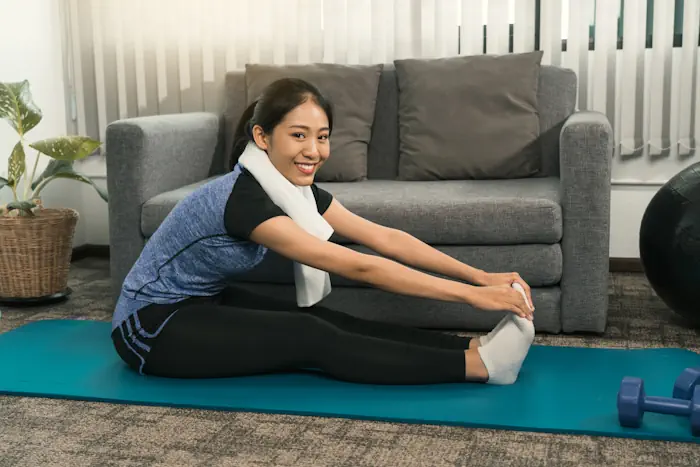Topics
The shoulder has a greater and more diverse range of motion compared to any other part of the body. It pivots on a ball-and-socket joint called the glenohumeral joint which facilitates forward and backward movement of the shoulder, as well as arm rotation and extension away from the body.
The joint is protected by a flexible capsule containing synovial fluid, a lubricant that aids in its smooth movement. The capsule is surrounded by ligaments, which connect bones to bones; tendons, which connect muscles to bones; and fluid-filled sacs called bursae, which cushion tendons and bones during motion.
This complex arrangement of soft tissues is responsible for the shoulder's remarkable flexibility but also makes it susceptible to trauma and chronic wear and tear.
What is frozen shoulder?
Frozen shoulder, also known as adhesive capsulitis, is characterised by stiffness and pain in the shoulder joint. This causes the range of motion of the shoulder to be limited.
The condition tends to worsen over time if left untreated. It predominantly affects adults between 40 and 60 years old, affecting women more frequently than males.
What causes frozen shoulder?
A frozen shoulder occurs when the capsule becomes thickened and inflamed. However, it is unclear why this process happens.
This condition can occur without apparent cause; nonetheless, the likelihood of having frozen shoulder increases if you have the following:
- Previous injury or trauma to the shoulders.
- Medical conditions such as thyroid, diabetes, heart disease or stroke.
- Immobilisation of the shoulder due to an injury.
What are frozen shoulder symptoms?
The symptoms of a frozen shoulder develop gradually over time and may include the following:
- Stiffness, inflammation, and pain in the shoulder joint that makes it hard to perform daily tasks.
- A reduced range of motion in the injured shoulder.
How is frozen shoulder diagnosed?
Your doctor would first question your general health and symptoms before conducting a thorough physical examination. Diagnosis is made based on your reported symptoms, physical examination, and investigations.
Additionally, your doctor may order certain imaging tests, such as an X-ray or magnetic resonance imaging (MRI), to rule out the possibility of other issues, such as arthritis or a rotator cuff injury.
How is frozen shoulder treated?
The primary aim of frozen shoulder treatment is to alleviate symptoms and restore shoulder motion and function. Some treatment options are as follows:
- Medications such as paracetamol or ibuprofen to reduce inflammation and relieve pain.
- Heat or ice pack therapy.
- Stronger pain medication, such as corticosteroid injections, reduces swelling.
- A physiotherapist may be recommended for shoulder range-of-motion and stretching exercises to improve movement.
- Surgery is recommended if your symptoms do not improve despite other treatment options.
What are the physical exercises for frozen shoulder?
Physiotherapy is the cornerstone of treatment, primarily focusing on stretching and strengthening activities. A physiotherapist may teach you the best frozen shoulder exercises to perform.
Pendulum exercise
- Stand and lean over slightly while relaxing your shoulders and let the injured arm hang loose.
- Next, gently swing the injured arm in a small circle with an approximate diameter of half a foot to one foot.
- Perform about 10 revolutions forward and backward.
- This exercise may be repeated 2 to 3 times a day.
Inward rotation
- Make use of an exercise resistance band or TheraBand.
- Hook one end of a resistance band around the doorknob of a closed door.
- Next, hold the other end with the hand of your injured arm while maintaining your elbow at a 90-degree angle.
- Pull the band towards your body.
- Hold for at least 5-10 seconds and release.
Outward rotation
- Make use of an exercise resistance band or TheraBand.
- Hold it between your hands, with your injured elbow, at a 90-degree angle.
- Gently rotate the lower part of the injured arm outwards, about 2 to 3 inches, and hold for 5 seconds.
- Repeat about 10 times.
- The exercise may be repeated 2 to 3 times a day.
Shoulder stretch
- Support the elbow of your affected shoulder with your opposite hand.
- Next, pull this elbow across your chest, towards the opposite shoulder.
- Hold this stretch for about 30 counts.
- Repeat 10 times. The stretch may be performed a few times a day.
Towel stretch
- You can do this by holding a towel with one hand behind your back and the other hand on the other end.
- Keep the towel horizontal and use your good arm to help stretch out your affected one.
- Perform these 10 to 20 times a day.
- Relax the stretch gradually, then do it again. However, you should not push yourself physically if doing so causes unbearable pain.
Cross-body stretch
- While seated or standing, support the injured arm with the other arm at the elbow.
- Stretch your shoulder by bringing it up and across your body.
- Hold this stretch for at least 15 to 30 seconds.
- Perform this about 10 to 20 times per day.
Cane exercise
- Lie on your back.
- Position a cane or broomstick so that it is flat across your hips. Your elbows should be straight, and your hands should be facing down.
- Use the non-injured arm to stretch out your damaged arm by lifting the cane above your head with your healthy arm.
- Hold the stretch for 30 seconds.
Many yoga asanas can help improve shoulder mobility. However, some of them may be hard to manage for beginners or those with severe pain in the shoulder joint. Here are two simple ones to try:
Bhujangasana (Cobra pose)
- While lying on your stomach (on a yoga mat), place your hands on the floor beside your body, with palms down.
- Next, put some weight on your palms while gently raising your body and torso. Breathe in when rising up.
- Straighten your arms and lift your chin to look up at the ceiling, resembling a cobra’s typical position.
- Hold the pose for 30 seconds.
- Exhale as you go back to the starting position.
Dhanurasana (Bow pose)
- Lie flat on your stomach.
- Keep your stomach on the floor and raise your upper body and legs off the ground.
- Extend your arms backwards to hold your feet.
- Hold the position for 30 seconds.
- Return to the original position.
Make an appointment at Pantai Hospitals
If you have a painful and stiff shoulder, it is recommended that you refrain from engaging in activities that make your shoulder pain worse. Speak to your doctor and physiotherapist about the best exercises for you.
The rehabilitation team at Pantai Hospitals are trained to provide the best care for our patients. Because each patient is different and will present with their own set of issues and symptoms, treatment plans are personalised.
A dedicated and expert team of Orthopaedic specialists at Pantai Hospitals is available for consultation to provide the best care possible.
Get in touch with us to book an appointment today if you have any concerns or questions about frozen shoulder diagnosis and treatment options.
Pantai Hospitals have been accredited by the Malaysian Society for Quality in Health (MSQH) for its commitment to patient safety and service quality.














